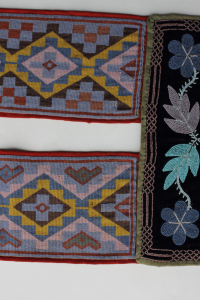Bandolier bag
Bandolier bag
Bandolier bag













Bandolier, stroud, loom woven beadwork pouch panel & straps, overlaid beadwork design, symmetrical & asymmetrical decorative beaded designs
from catalogue records
Summary of catalogue records
Read More About This Relative
Cotton fabric, velvet, seed beads, tube beads, bias tape, wool, cotton thread.
Rectangular pouch panel with a pair of unattached straps, Three types of cloth incorporated into pouch panel, patterned cloth on bottom, cotton muslin in middle, black velvet on top portion, Beige cotton muslin backing, pouch is black cotton velvet with green & red print cotton backing, Loom woven beadwork panel on pouch of multi-coloured opaque, semi-translucent, translucent and iridescent beads, Sides and bottom edges of shoulder panel has red wool bias tape border, Sides, top edge, and opening of pouch and back panel is blue wool border, Wool braid ends form a fringe at each bottom corner of pouch, Along bottom edge of pouch loom woven panel are seven loom woven beaded tabs, Each strap has five loom woven tabs along top edge, All tabs bear two or three wool tassels with cylindrical beads.
Motifs and Images: Geometric designs applied to central area of pouch panel in a symmetrically arranged classic "X" motif, Dissimilar diamond motifs along straps, Multi-coloured opaque, semi-translucent, translucent and iridescent beads, Otter tail beadwork along pouch sides and top, Two large flowers and two leaves symmetrically connected by small spiked double stems laid down in an appliqué floral design of overlaid spot stitch beadwork on small panel above pouch, Loom woven beaded tabs in geometric design.
Bandolier bags most likely originated in the Upper Great Lakes region during the 1840s and 1850s. Fashioned exclusively from European materials and adorned with thousands of beads, bandolier bags were primarily for show, as a symbol of identity, wealth and status. Although initially functional, by the late 19th and early 20th centuries many of the bags had false pouches or none at all. Sometimes called "friendship bags", they were often created as gifts to strengthen relationships within communities or between nations. By the 1870s they had become an important element of formal dress worn mainly at ceremonies and celebrations by men, and occasionally by women. They wore them - singly or several at a time - crossed over the torso or draped around the neck. The wearing of more than one bag was generally the prerogative of a leader or a person of high honour. (McCord, 2013). Bandolier adopted by Ojibwa in 19th century after seeing bullet pouches used by British soldiers. Bullet pouches were plain and decorated with crest or coat of arms. When idea adopted by Ojibwa, they were greatly prized and highly decorated ceremonial accessories. They became so highly prized by Ojibwa and other tribes (especially Sioux), that one bandolier could be traded for one pony. They became a status symbol of highest ranking Midewiwin priests.
From catalogue records.
Provenance
The original owner Nathaniel Murdock William John McKenzie took a contract with the HBC in 1876 as a carpenter serving at Fort Ellice in Southwestern Manitoba; rising through the ranks from this position to Post Manager, Clerk in Charge, Clerk and Trader, and finally District Manager for the Lake Huron and Lake Superior regions, retiring in 1914. During his employment, he worked in Manitoba, Saskatchewan and in the northern Great Lakes region.
Hudson's Bay Company Winnipeg Fur Trade Department collected materials in preparation for 250th anniversary celebrations of the HBC in 1920. Many of these items were used in the Processions and Pow Wow at Lower Fort Garry in May, 1920.
McCord Museum, Wearing Our Identity. Montreal: The McCord Museum, 2013; Print.
The Hudson's Bay Company Winnipeg Fur Trade Department collected materials in preparation for 250th anniversary celebrations of the HBC in 1920. Many of these items were used in the Processions and Pow Wow at Lower Fort Garry in May, 1920.
One of 25,000 of artefacts from the original Hudson's Bay Company Museum Collection which was donated to the Manitoba Museum by the HBC in 1994.
About This GRASAC Record
Manitoba Museum
46.8139, -71.208
Northeast Great Lakes Riverine
 Knowledge Sharing Platform
Knowledge Sharing Platform












